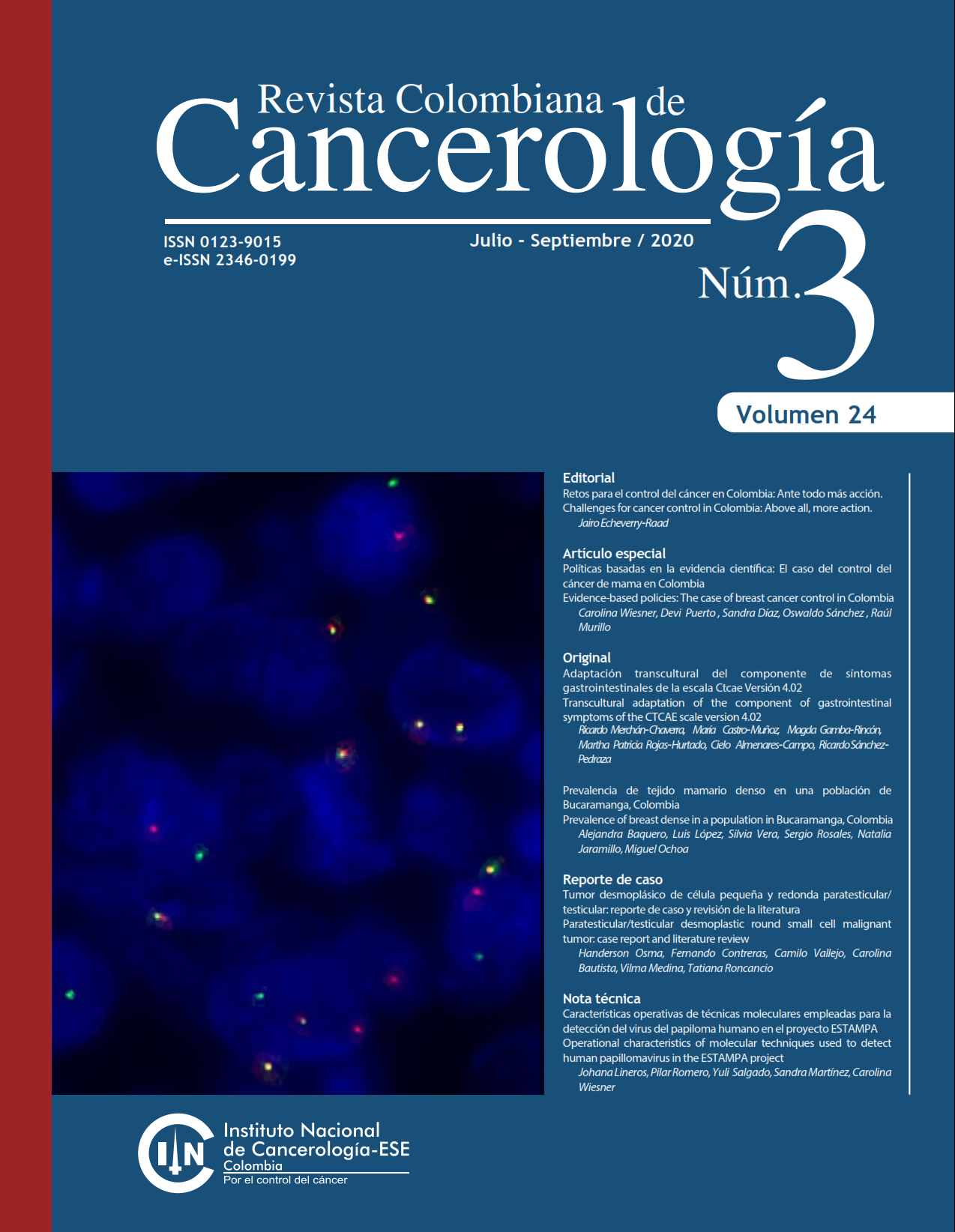Prevalence of breast dense in a population in Bucaramanga, Colombia
DOI:
https://doi.org/10.35509/01239015.94Keywords:
Mammography, Breast, Diagnosis, Mass ScreeningAbstract
Introduction: The presence of dense breast tissue in women is a condition that makes it difficult to assess and adequately interpret mammography, possibly masking suspicious lesions of malignancy. Recent studies suggest the performance of complementary studies for the screening and diagnostic approach of these patients.
Objective: To establish the prevalence of women over 50 with dense breasts in Bucaramanga city studied by mammography and evaluate the performance of complementary studies
Materials and methods: A retrospective descriptive study was conducted during the period from January 1, 2014 to August 31, 2015, 10,110 mammograms were reviewed in patients over 50 years of age. Subsequently, a review of the literature in the main databases was made.
Results: 10110 mammograms were performed, 4448 were found to be positive for dense breast. 39.69% was heterogeneously dense breast tissue, and 4.29% extremely dense; The result was 43.9% patients with positive dense breasts
Discussion: Breast density is an independent risk factor for breast cancer, being of medium importance compared to other factors. As the breast density increases, the overlap of the radiopaque breast tissue that can hide and delay the diagnosis of an underlying cancer is generated
Conclusion: Given the high prevalence of dense breast tissue found in our population, current evidence suggests complementing screening with other imaging methods, individualizing each patient.
References
Winkler NS, Raza S, Mackesy M, Birdwell RL. Breast density: clinical implications and assessment methods. Radiographics. 2015; 35(2): 316-24. https://doi.org/10.1148/rg.352140134
Boyd NF, Martin LJ, Yaffe MJ, Minkin S. Mammographic density and breast cancer risk: current understanding and future prospects. Breast Cancer Res. 2011; 13(6):223. https://doi.org/10.1186/bcr2942
Boyd NF, Guo H, Martin LJ, Sun L, Stone J, Fishell E, et al. Mammographic density and the risk and detection of breast cancer. N Engl J Med. 2007;356(3):227-36. https://doi.org/10.1056/NEJMoa062790
Nazary S, Mukherjee P. An overview of mammographic density and its association with breast cancer. Breast cancer. 2018;25(3):259-67. https://doi.org/10.1007/s12282-018-0857-5
Hooley RJ. Breast density legislation and clinical evidence. Radiol Clin North Am. 2017;55(3):513-26. https://doi.org/10.1016/j.rcl.2016.12.006
Wolfe JN. Risk for breast cancer development determined by mammographic parenchymal pattern. Cancer. 1976;37(5):2486-92. https://doi.org/10.1002/1097-0142(197605)37:5<2486::AIDCNCR2820370542>3.0.CO;2-8
Wolfe JN. Breast patterns as an index of risk for developing breast cancer. AJR Am J Roentgenol. 1976;126(6):1130-7. https://doi.org/10.2214/ajr.126.6.1130
Freer P. Mammographic dreast density: impact on breast cancer risk and implications for screening. Radiographics. 2015; 35(2): 302-15. https://doi.org/10.1148/rg.352140106
Bae MS, Moon WK, Chang JM, Koo HR, Kim WH, Cho N, et al. Breast cancer detected with screening US: reasons for nondetection at mammography. Radiology. 2014;270(2):369-77. https://doi.org/10.1148/radiol.13130724
Yi A, Chang JM, Shin SU, Chu AJ, Cho N, Noh DY, et al. Detection of noncalcified breast cancer in patients with extremely dense breasts using digital breast tomosynthesis compared with fullfield digital mammography. Br J Radiol. 2019;92(1093):20180101. https://doi.org/10.1259/bjr.20180101
Dehkordy S, Carlos R. Dense breast legislation in the United States: state of the states. J Am Coll Radiol. 2013;10(12):899-902. https://doi.org/10.1016/j.jacr.2013.09.007
Horny M, Cohen AB, Duszak R Jr, Christiansen CL, Shwartz M, Burgess JF Jr. Dense breast notification laws: impact on downstream imaging after screening mammography. Med Care Res Rev. 2020;77(2):143-54. https://doi.org/10.1177/1077558717751941
McCormack VA, dos Santos Silva I. Breast density and paren¬chymal patterns as markers of breast cancer risk: a meta-analysis. Cancer Epidemiol Biomarkers Prev. 2006;15(6):1159-69. https://doi.org/10.1158/1055-9965.EPI06-0034
Melnikow J, Fenton JJ, Whitlock EP, Miglioretti DL, Weyrich MS, Thompson JH, et al. Supplemental screening for breast cancer in women with dense breasts: a systematic review for the U.S. Preventive Service Task Force. Ann Intern Med. 2016;164(4):268-78. https://doi.org/10.7326/M15-1789
Carney PA, Miglioretti DL, Yankaskas BC, Kerlikowske K, Rosenberg R, Rutter CM, et al. Individual and combined effects of age, breast density, and hormone replacement therapy use on the accuracy of screening mammography. Ann Intern Med. 2003;138(3):168-75. https://doi.org/10.7326/0003-4819-138-3-200302040-00008
Kerlikowske K, Hubbard RA, Miglioretti DL, Geller BM, Yankaskas BC, Lehman CD, et al. Comparative effectiveness of digital versus film-screen mammography in community practice in the United States: a cohort study. Ann Intern Med. 2011;155(8):493-502.https://doi.org/10.7326/0003-4819-155-8-201110180-00005
Carreira Gómez MC, Estrada Blan MC. Mama densa, ¿qué debemos saber? Implicaciones en el cribado. Radiología. 2016;58(6):421-6. https://doi.org/10.1016/j.rx.2016.08.002
Noroozian M, Hadjiiski L, Rahnama-Moghadam S, Klein KA, Jeffries DO, Pinsky RW, et al. Digital breast tomosynthesis is comparable to mammographic spot views for mass characterization. Radiology. 2012; 262(1):61-8. https://doi.org/10.1148/radiol.11101763
Destounis S. Role of Digital breast tomosynthesis in screening and diagnostic breast imaging. Semin Ultrasound CT MRI. 2018;39(1):35-44. https://doi.org/10.1053/j.sult.2017.08.002
Jo HM, Lee EH, Ko K, Kang BJ, Cha JH, Yi A, et al. Prevalence of women with dense breasts in Korea: results from a nationwide cross-sectional study. Cancer Res Treat. 2019;51(4):1295-301. https://doi.org/10.4143/crt.2018.297
How to Cite
Downloads
Downloads
Published
Issue
Section
License
Copyright (c) 2020 Revista Colombiana de Cancerología

This work is licensed under a Creative Commons Attribution-NonCommercial-NoDerivatives 4.0 International License.
Todos los derechos reservados.





